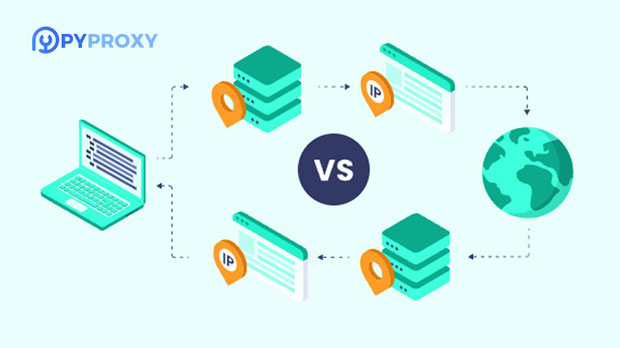For Apple iPhone users, the convenience of a free socks5 proxy can seem enticing as it offers an easy way to access restricted content or ensure privacy. However, there are crucial aspects to consider when using such proxies. Free socks5 proxies may come with various risks, such as security vulnerabilities, slower speeds, or potential data privacy concerns. Understanding these issues beforehand is essential to avoid compromising your privacy or user experience. In this article, we will analyze the advantages and risks associated with free SOCKS5 proxies for iPhone users, offering a clear understanding of what to watch out for and how to use them safely. 1. Understanding SOCKS5 Proxy and Its FunctionsBefore diving into the details, it’s essential to understand what SOCKS5 proxies are and how they work. SOCKS5 is a type of proxy server that acts as an intermediary between your device and the internet. It routes your traffic through a third-party server, masking your IP address and providing a level of anonymity. Unlike other proxy types, SOCKS5 supports a wide range of protocols, such as HTTP, FTP, and even DNS requests, making it versatile and suitable for various online activities.For Apple iPhone users, a SOCKS5 proxy can help in situations where you want to bypass geographical restrictions or encrypt your internet traffic. However, while SOCKS5 proxies may seem appealing for their simplicity and ease of use, their free versions often come with limitations that could affect the quality of your browsing experience.2. Security Risks of Free SOCKS5 ProxiesOne of the most significant concerns when using free SOCKS5 proxies on your iPhone is the potential security risks. Free proxy servers often lack the robust encryption and security measures that paid services offer. This can lead to several vulnerabilities:- Data Interception: Since the data you send through a proxy is not always encrypted, hackers or malicious third parties could intercept your traffic. This can lead to sensitive information, such as login credentials or financial data, being exposed. - Malware Risks: Free proxies may not have the same level of oversight and regulation as paid services. As a result, malicious software could be bundled with the proxy connection, potentially leading to malware infections on your device.- Man-in-the-Middle Attacks: With insufficient encryption, free SOCKS5 proxies are more susceptible to man-in-the-middle attacks, where hackers intercept and modify your communication with websites or services.For these reasons, it's crucial to use caution and ensure that the proxy you choose offers adequate security measures. It’s also wise to use additional security tools, such as a VPN or secure browsing extensions, to enhance your protection.3. Privacy Concerns with Free SOCKS5 ProxiesPrivacy is another critical factor to consider when using free SOCKS5 proxies on your iPhone. Although proxies can mask your IP address, they do not inherently guarantee privacy. free socks5 proxy services often track your online activity for various purposes, including advertising or selling user data. When using a free proxy, you are essentially entrusting the provider with your internet activity. However, free services may log your browsing history or other personal information, which can later be shared with third parties. This could defeat the purpose of using a proxy in the first place, especially if your goal is to maintain privacy.To ensure that your privacy is protected, it’s vital to:- Review the Privacy Policy: Before using a free SOCKS5 proxy, read the provider’s privacy policy carefully to understand what data they collect and how it is used. - Consider Paid Alternatives: If privacy is a top priority, consider opting for a paid SOCKS5 proxy service that offers a no-log policy and stronger privacy safeguards.4. Speed and Performance LimitationsFree SOCKS5 proxies often come with significant speed and performance limitations. Since these proxies are typically provided at no cost, they may be overburdened with users, resulting in slower internet speeds. This can lead to issues like buffering, longer load times for websites, and interruptions during video streaming or online gaming.Furthermore, the free socks5 proxy servers may not have sufficient bandwidth to handle high-demand activities such as video streaming or large file downloads. This can significantly degrade the user experience on your iPhone.If speed is a critical factor for your internet usage, it’s important to understand that free proxies may not deliver the performance you need. You may experience reduced speeds, especially during peak hours, due to the high volume of users sharing the same proxy server.5. Legal and Ethical ImplicationsUsing a free SOCKS5 proxy may not always align with legal and ethical standards. Some free proxies could be used for illicit activities, such as bypassing geo-restrictions for illegal content, or they may facilitate piracy or other unauthorized actions. It’s important to understand that by using a proxy, you are still subject to the laws and regulations of your country and the services you access.Moreover, if the proxy provider is engaging in illegal activities or violating any terms of service, you could inadvertently become involved. To avoid these issues, ensure that your use of a SOCKS5 proxy is in line with local laws and the acceptable use policies of the services you are accessing.6. Compatibility with iPhone and iOSWhile configuring a SOCKS5 proxy on your iPhone is relatively straightforward, there are still some compatibility issues to be aware of. Not all applications on iOS are designed to work with SOCKS5 proxies, and some apps may bypass the proxy settings entirely, leaving your traffic exposed. Additionally, using a proxy can sometimes interfere with push notifications or app functionality, as some services may detect unusual traffic patterns.Before setting up a SOCKS5 proxy, ensure that your iPhone’s iOS version supports the configuration. If you’re using third-party apps for proxy management, verify their compatibility and read user reviews to ensure that they work as advertised.7. Best Practices for Using Free SOCKS5 Proxies SafelyTo minimize the risks associated with using free SOCKS5 proxies on your iPhone, consider the following best practices:- Use HTTPS Websites: When browsing, always look for websites that use HTTPS encryption to add an extra layer of security, even when using a proxy. - Keep Your Device Updated: Ensure that your iPhone’s iOS and apps are up to date to protect against security vulnerabilities.- Limit Sensitive Transactions: Avoid accessing sensitive accounts or making financial transactions while connected to a free SOCKS5 proxy.- Test the Proxy: Before relying on a free SOCKS5 proxy for important tasks, test its speed, security, and reliability to ensure it meets your needs.- Use Complementary Tools: Consider using a VPN in conjunction with a SOCKS5 proxy for added security, particularly for tasks requiring higher privacy levels.8. ConclusionWhile free SOCKS5 proxies can provide a convenient solution for Apple iPhone users looking to bypass restrictions or improve privacy, they come with numerous risks. These risks include potential security threats, privacy concerns, performance limitations, and legal implications. It’s crucial to weigh these factors carefully and understand the limitations of free proxies before relying on them for critical tasks. By taking appropriate precautions, such as ensuring security measures, reviewing privacy policies, and using complementary tools, you can mitigate some of these risks. However, for those prioritizing security, privacy, and reliability, investing in a paid proxy or VPN service may ultimately provide better protection and performance.
Jan 07, 2025
![arrow]()




























































